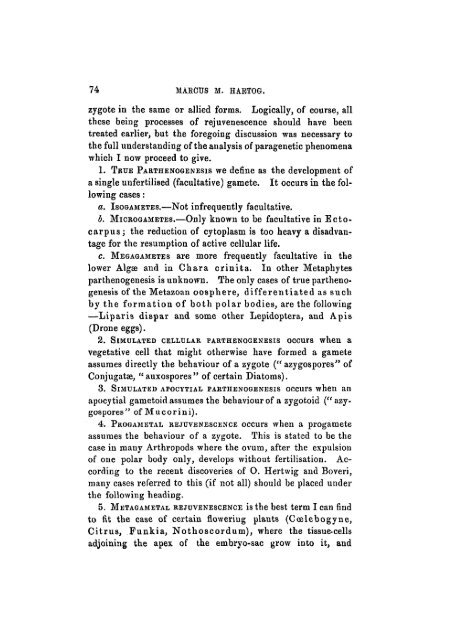Some Problems of Reproduction: a Comparative Study of ...
Some Problems of Reproduction: a Comparative Study of ...
Some Problems of Reproduction: a Comparative Study of ...
Create successful ePaper yourself
Turn your PDF publications into a flip-book with our unique Google optimized e-Paper software.
74 MARCUS M. HARTOG.<br />
zygote in the same or allied forms. Logically, <strong>of</strong> course, all<br />
these being processes <strong>of</strong> rejuvenescence should have been<br />
treated earlier, but the foregoing discussion was necessary to<br />
the full understanding <strong>of</strong> the analysis <strong>of</strong> paragenetic phenomena<br />
which I now proceed to give.<br />
1. TRUE PARTHENOGENESIS we define as the development <strong>of</strong><br />
a single unfertilised (facultative) gamete. It occurs in the following<br />
cases:<br />
a. ISOGAMETES.—Not infrequently facultative.<br />
b. MICROGAMETES.—Only known to be facultative in Ectocarpus;<br />
the reduction <strong>of</strong> cytoplasm is too heavy a disadvantage<br />
for the resumption <strong>of</strong> active cellular life.<br />
c. MEGAGAMETES are more frequently facultative in the<br />
lower Algse and in Chara crinita. In other Metaphytes<br />
parthenogenesis is unknown. The only cases <strong>of</strong> true parthenogenesis<br />
<strong>of</strong> the Metazoan oosphere, differentiated as such<br />
by the formation <strong>of</strong> both polar bodies, are the following<br />
—Liparis dispar and some other Lepidoptera, and Apis<br />
(Drone eggs).<br />
2. SIMULATED CELLULAR, PARTHENOGENESIS occurs when a<br />
vegetative cell that might otherwise have formed a gamete<br />
assumes directly the behaviour <strong>of</strong> a zygote (" azygospores" <strong>of</strong><br />
Conjugatse, " auxospores" <strong>of</strong> certain Diatoms).<br />
3. SIMULATED APOCYTIAL PARTHENOGENESIS occurs when an<br />
apocytial gametoidassumes the behaviour <strong>of</strong> a zygotoid ("azygospores"<br />
<strong>of</strong> Mucorini).<br />
• 4. PROGAMETAL REJUVENESCENCE occurs when a progamete<br />
assumes the behaviour <strong>of</strong> a zygote. This is stated to be the<br />
case in many Arthropods where the ovum, after the expulsion<br />
<strong>of</strong> one polar body only, develops without fertilisation. According<br />
to the recent discoveries <strong>of</strong> O. Hertwig and Boveri,<br />
many cases referred to this (if not all) should be placed under<br />
the following heading.<br />
5. METAGAMETAL REJUVENESCENCE is the best term I can find<br />
to fit the case <strong>of</strong> certain flowering plants (Coelebogyne,<br />
Citrus, Funkia, Nothoscordum), where the tissue-cells<br />
adjoining the apex <strong>of</strong> the embryo-sac grow into it, and

















